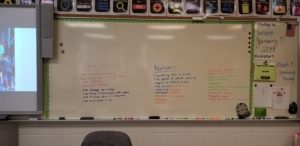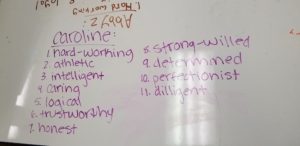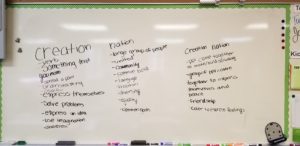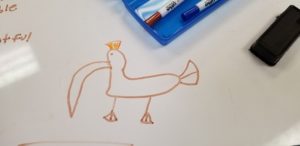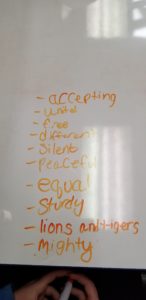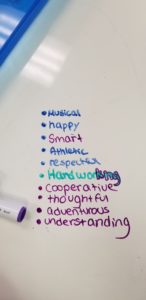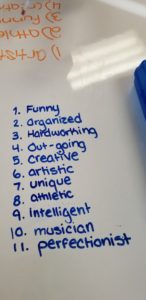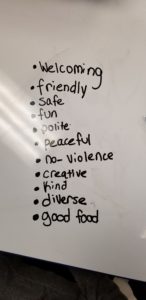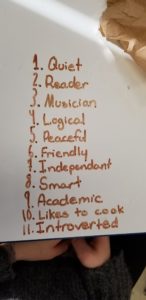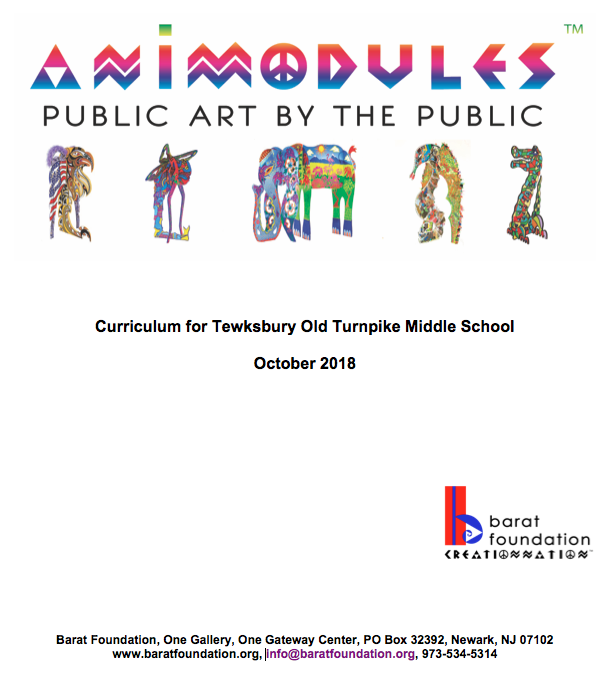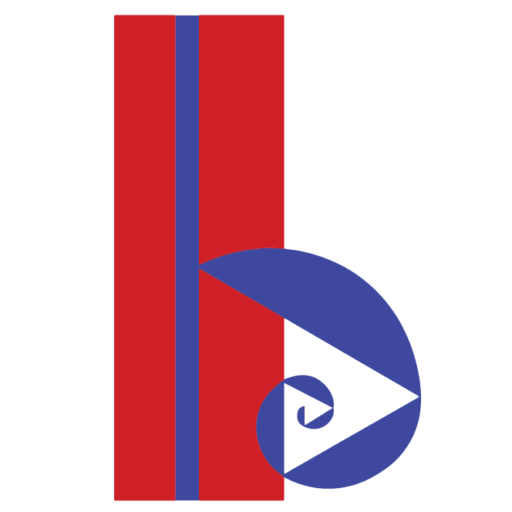Tewksbury
Session 1 – Introduction – Welcome to the Creation Nation!
The Aluminum Leaping Tiger Animodule is delivered to the school. Creation Nation is a borderless kingdom that welcomes all, and encourages learners to become creators – both of the artwork at hand, and moreover of their own lives. Introducing students to Creation Nation and Animodules™, Newark’s Official Peace Ambassadors”, including the Creation Nation Art & Peace ParadeVideos of Animodule making and the parade are shown including:
A discussion of what it means to be a creator, vs. being a critic, vs. being a consumer. Do we want only to criticize other people’s work, or consume other people’s products? Where is the larger reward? What can we create ourselves? Why do we want to be creators? Who are the creators who have changed the world? How can we discover, celebrate and honor our individual uniqueness and creativity? This process brings the students into the realm of Creation Nation and into an exercise in abstract thought. What is Creation? What is a Nation? Can a nation without borders exist? What does it mean to work together towards a common goal? What do we have in common with people from different parts of the world? Can this be the basis of a “nation”?
Creation Nation – Word Definitions
We ask a student to write the word “Creation” on a large board
We ask the class to define Creation, and the student writes the definitions on the board.
We ask a student to write the word “Nation” on the large board
We ask the class to define Nation, and the student writes the definitions on the board.
Lastly, we ask a student to write “Creation Nation” on the large board
We ask the class to define Creation Nation.
General Notes:
Mission
Public Art by the Public: Engaging youth in the process of collaborative artistic creation, fostering peacemaking through the arts and promoting the civic ideals of inclusion, diversity, pride of place, and the beautification of public space.
Vision
Students engage in collaborative, hands-on art making that is directly linked to their academic curriculum reinforcing learning while creating a lasting work of art that represents their experience and community.
Objectives
Empower students to directly contribute to their community by creating public art that reflects and amplifies their voice and values in the public landscape.
Core Beliefs
Each one of us is innately creative, and has the potential to add our unique vision and voice to uplift the local and global community. The Animodules serve as a conduit to elicit this voice and give it tangible expression in the form of a lasting work of art that honors both its creators and the creative process.
Learning Objectives and Outcomes:
- To understand the role of public art, and the students’ role in creating it.
- To know how to design public art
- To be able to use materials effectively and think about innovative design ideas
- To work collaboratively in an interdisciplinary modeto develop sculptural art related to themes in their science curriculum
- To extend their work by having their Animodule worksheets translated onto a “living sculpture” that takes elements of their curriculum, and “freezes” them on a permanent, universal work of art.
SMART Goal Worksheet: Define your SMART goal for the project.
What is a SMART goal:
S = Specific (clear, detailed, well-defined)
M = Measurable (numbers, quantity, comparison)
A = Achievable (possible, can be accomplished)
R = Realistic (is it achievable by you considering the time, resources, knowledge and skills that you have access to?)
T = Time bound (defined time-line:
Step 1 – Be Specific
Specific means that the goals is clear, detailed, focused and well defined. It includes action and a result. Goals need to communicate what you would like to see happen. To set specific goals it helps to ask the following questions:
• WHAT am I going to do
• WHY is this important for me to do?
• WHO is going to do what? Who else need to be involved?
• WHEN do I want to do this
• HOW am I going to do this
Example of a specific goal:
• I am going to clean up a local park by recruiting volunteers from the school to pick up trash each Saturday and getting 10 trans cans donated to the park by the spring of 2019.
Example of a goal that is not specific
• I am going to clean up a park somewhere with volunteers and by getting donations.
What is our specific goal?
________________________________________________________________
2. Step 2 – Measure It
If the goal is measurable, it means we are able to know if we achieved it. If you use numbers and/or comparison in your goal, this will help you to know if you achieved it.
Example of measurable goals:
• Raise $100 to purchase 25 books for the school library
• Get 10 trash cans to the park
• Recruit 10 volunteers to clean the park on Saturdays
Examples of goals that are not measurable:
• Cleaning up a park
• Raising money to purchase books
• Recruiting volunteers
Is our specific goal measurable. If not, make it measurable. Write our Specific,
Measurable goal here:
________________________________________________________________
Step 3 – Make it Achievable
Goals need to be achievable. If the goal is too far in the future, you might find it difficult to keep motivated to reach it. If you have to gain a lot of skills in order to achieve the goal, you may get frustrated. Goals still need to challenge you, but not so much that you become too frustrated and lost motivation.
Think about what is achievable for our group.
Examples of goals that are achievable in the time frame we have:
• Each student completes their individual Animodule design
• A final sculpture is completed under the guidance of the artist in residence
Examples of goals that are not achievable in the time frame we have:
• We create a sculpture garden for the school including several Animodules
• We create a sculpture garden for the Whittemore Nature Preserve
Is your specific, measurable goal achievable? If not, make it achievable. Write our Specific, Measurable, Achievable goal here:
________________________________________________________________
Step 4: Be Realistic:
Goals that are achievable may not be realistic. Realistic means that you have the resources to get it done. The achievement of a goal requires resources such as skills, materials, equipment, and other people to support the tasks required to achieve the goal.
Examples of goals that are achievable and realistic:
• Students will complete their individual designs
• The artist in residence will organize the artwork and lay it out on the final piece
• Our Animodule will be completed
Examples of a goal that is achievable but not realistic:
• One student’s design will be chosen for the final sculpture. Even though each student will complete a design for the Animodule, it is not realistic to think that one student’s design would be exclusively chosen to represent the entire class or community.
Is our Specific, Measurable, Achievable Goal realistic? If not, make it realistic.
Write our Specific Measurable, Achievable, Realistic goal here:
________________________________________________________________
Step 5 – Time-bound
Time-bound means setting deadlines for the achievement of the goal. Deadlines create the necessary urgency to take action.
Example of a time-bound goal:
• Each student will complete their Animodule Drawing prior to day 4 of the program
• The final sculpture will be completed within a week of the final group painting.
Example of a goal that is not time-bound
• Each student will complete their Animodule Drawing
• The final sculpture will be completed
Does your Specific, Measurable, Achievable, Realistic goal have a time limit?
Class Plan Overview
| Week 1 | Week 2 | Week 3 | Week 4 | Week 5 |
| Introduction to Animodule™ Project | Your Animodule™ | Individual design process continues | Artist in Residence returns with collaboratively created design of Animodule on Actual Sculpture | Continuation of Painting of the Animodule Sculpture |
| Videos of Creation Nation Parade and Slide Show of Animodule Sculptures | Pouncing Tiger – What does it symbolize?
How can we relate it to your science curriculum? |
Artist in Residence works with students on integrating science curriculum onto student Animodule forms | Discussion of Final Form | Exploration of the meaning and importance of the public art being created |
| Word Exploration
Creation Nation What does Creation Mean? What does Nation Mean? |
Exploration of the role of art with technology and science | Painting of Animodule begins | Identify target audiences for final piece
Identify a site for the art in the school campus |
|
| What is public art?
Where have you seen it? |
Hands on Design – Each student introduced to incorporating science designs on worksheet Animodule | Post Project Survey Administered | ||
| Create SMART Goal |
Week 1 Lesson Plan
| Objective: | 1) Introduce Project
2) Consider issues affecting public art 3) Consider role of creators and art in society 4) Create SMART Goal |
| Materials: | Internet
Computers for student pre-project survey Smart Board |
| Preparation: | Read over SMART Goals
Familiarize with local Public Art |
| Time Allotted | Activity |
| 10 Minutes | Videos and slide shows of Creation Nation Art & Peace Parade and Animodules |
| 10 Minutes | Pre-Project Student Survey |
| 10 Minutes | Word Exploration – Creation & Nation and discussion of Public Art
Group discussion of what does Creation mean? Group discussion of what does Nation mean? Group discussion of what is public art? |
| 15 Minutes | SMART Goal
Objective: Define goal for the project Share handout with the students or work collectively on Smart Board. Explain SMART goals to them using the handout as a guide. |
Does your Specific, Measurable, Achievable, Realistic goal have a time limit? White our specific, Measurable, Achievable, Realistic, Time-bound goal here:
Week 2 Lesson Plan
| Objective | Exploration of interdisciplinary projects incorporating art with science and technology
Introduce Animodule Design Sheets to students and begin individual student design process |
| Materials: | Animodule Design Sheets
Markers Scissors |
| Preparation: | Printing of Animodule Design Sheets
Discussion of science-related images to be placed on Animodule |
| Time Allotted | Activity |
| 10 Minutes | Discussion of relationship between art, science, and technology |
| 35 Minutes | Hands on: Students begin working on their individual science-related design elements to be placed on the final artwork Each student to sign their work in order to continue work through week 3. |
Week 3 Lesson Plan
| Objective | Completion of individual student design elements for incorporation onto final Animodule |
| Materials | Markers, Student Design Sheets |
| Preparation | Distribution of student artwork begun on week 2 |
| Time Allotted | Activity |
| 5 minutes | Hand out of students’ artwork
Discussion of progress made |
| 40 minutes | Completion of student designs |
Week 4 Lesson Plan
| Objective | Begin actual painting of Animodule Sculpture |
| Materials | Paints, brushes, tarps, aprons – to be delivered by Barat Foundation Staff |
| Preparation | Artist in residence – outlined and color coded Animodule for painting |
| Time Allotted | |
| 5 Minutes | Set up of materials, distribution of aprons |
| 30 Minutes | Student painting of the Animodule under the guidance of the Artist in residence |
| 5 Minutes | Clean up |
Week 5 Lesson Plan
| Objective | Complete student portion of Animodule painting of the Sculpture |
| Materials | Aluminum Animodule sculpture
Paints, brushes, tarps, aprons Computers for student surveys |
| Preparation | Maintenance of Animodule sculpture
Artist in residence – work on finalizing student work from Week 4 |
| Time Allotted | |
| 5 Minutes | Set up of materials, distribution of aprons |
| 25 Minutes | Student painting of the Animodule under the guidance of the Artist in residence |
| 5 Minutes | Clean up |
| 10 Minutes | Student Post-Project Survey administered |
